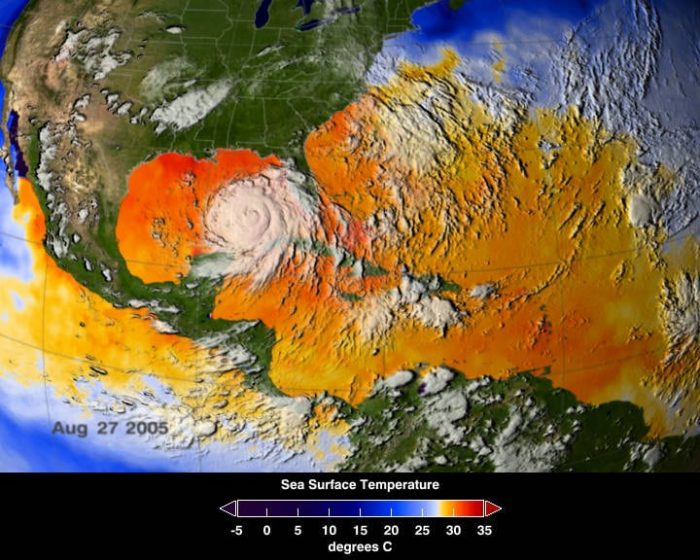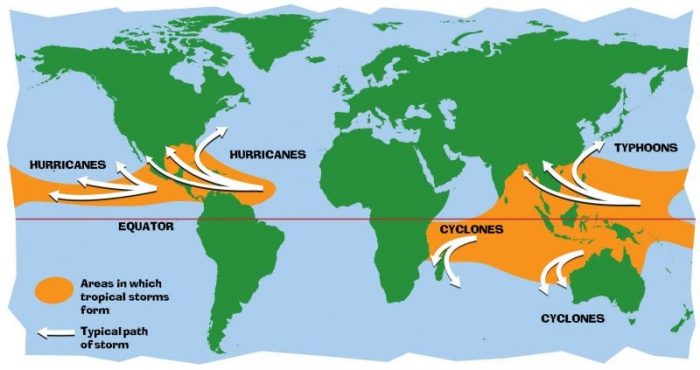
Hawaii’s hurricane season is from June to November of every year, but just how much of a threat to Hawaii are hurricanes? How frequent are hurricanes in Hawaii?
One might think that hurricanes are severe threats to the Hawaiian islands, as many islands found in the middle of the Pacific are at high risk of being hit by hurricanes. Yet unlike many other islands, Hawaii actually sees hurricanes fairly rarely. There are a variety of reasons that Hawaii doesn’t experience many hurricanes, including the island’s location and a nearby high-pressure area. Let’s explore Hawaii’s relationship with hurricanes in greater detail.
Where Is Hawaii?
The islands of Hawaii are situated at approximately 19.8968° N, 155.5828° W, in the middle of the Pacific Ocean between the Philippines and North America. Because of Hawaii’s centralized location in the Pacific, it functions as a stopover for many planes and ships. It also functions as a major hub of transit for people and goods headings to regions on either side of the Pacific. Note Hawaii’s GPS coordinates, as they are important for understanding its positioning relative to areas with frequent tropical storms and hurricanes.
Some Facts About Hurricanes And Their Formation
Hurricanes are only capable of forming over the warmer ocean waters that are near the Earth’s equator. This is because the moist, warm air of the waters near the equator is rising upwards and away from the surface, leaving a low air pressure area below the rising air. The air in surrounding regions of higher air pressure then rushes into the low-pressure area to fill it in, but then that new column of air also become warm and moist and rises as well. The moist air continues to rise and cool off and at higher altitudes, forming clouds. This cycle of warm moist air and descending cool air combines with the wind to create a spinning system of clouds, moisture, and air. The storms that form south of the equator spinning clockwise, while the storms which end up forming north of the equator spin counterclockwise.
As the wind speeds continue to accelerate in the system, they reach speeds which can destroy structures when they hit a body of land. Hurricane-force winds can easily occupy an area with a radius approaching 200 miles, and can last up to two weeks long. The average duration of a hurricane is about six days, however. Hurricanes are capable of heavily damaging coastal areas, causing mass flooding by raising the sea levels up to 30 feet in the areas they make landfall, pushing large amounts of earth and sand around, and throwing heavy or sharp objects through the air.

Warm waters often lead to the generation of hurricanes. Photo: NASA, Public Domain
Most hurricanes, about two-thirds of them, occur in the northern hemisphere, in one of two different latitude ranges. One of the common latitude ranges for hurricanes is between 4 and 22 degrees south latitude, while the other latitude range is between 4 and 35 degrees north latitude.
Thankfully, despite the damage that hurricanes can cause to life, property, and the environment, Hawaii actually experiences substantially fewer hurricanes than many other island regions or coastal areas. United States scientists have monitored hurricanes since around 1950, and during the six decades to follow, only approximately four hurricanes have hit the islands with enough force to do substantial damage. Most of these hurricanes did indeed occur between June to November. Hurricanes are more likely to appear in the late summer because the surface of the ocean is warmer at this time of year, which creates low-pressure areas.
The Most Damaging Hawaii Hurricanes
There are between four to six tropical cyclones that form in the middle of the Pacific every year, yet despite this, only four hurricanes have done substantial damage to the islands of Hawaii. These hurricanes were Iniki, Iwa, Dot, and Nina.
Hurricane Nina formed south of Hawaii in November of 1957 and did approximately 100,000 dollars of damage to the island. Hurricane Dot hit just south of Hawaii in August of 1959 and did a few million dollars in damage. Hurricane Iwa did approximately 250 million dollars of damage to Hawaii in November of 1982. Hurricane Iniki hit the island in September of 1992 and causes approximately 3.1 billion dollars in damage.
For a point of comparison, the mainland United States experiences about seven hurricanes every four years. Florida alone has experienced four different major hurricanes since 2010.
Why Is Hawaii Relatively Safe From Hurricanes?
One of the reasons that Hawaii doesn’t experience many hurricanes is just that it is a rather small target. The Pacific Ocean is vast and Hawaii is fairly small in comparison, meaning that its relatively unlikely any individual hurricane will hit the island group. Yet there is another reason that Hawaii doesn’t experience many hurricanes.

Hurricane paths across the world. Photo: NASA.gov, Public Domain
As it happens, Hawaii is fortunate enough to have a high-pressure region located just to its northeast. This area of high pressure helps ensure that water temperatures are fairly stable over of the year, meaning that relatively few hurricanes form in the region. The high-pressure area essentially helps shield the islands from large, powerful storms. This high-pressure area keeps the water near Hawaii cool, and since hurricanes need warm water to form they are less likely to occur near the islands. The westerly currents near the islands also create wind shears that aren’t very conducive to the formation of hurricanes. These combined effects mean that storms generally don’t get to close to the islands and if they do they generally become substantially weaker.
The most common path that hurricanes moving through the central Pacific Ocean take is to the south of Hawaii. The ocean is warmer in this southern region, close to the equator. Three of the four devastating hurricanes to hit Hawaii in the last 60 years all formed in the south of Hawaii. Hurricane Iniki occurred when an aberration in the south westerlies let the storm track to the north.
However, environmental scientists worry that climate change could be causing this high-pressure system to destabilize, and as a consequence, Hawaii could see more devastating hurricanes in the future.









